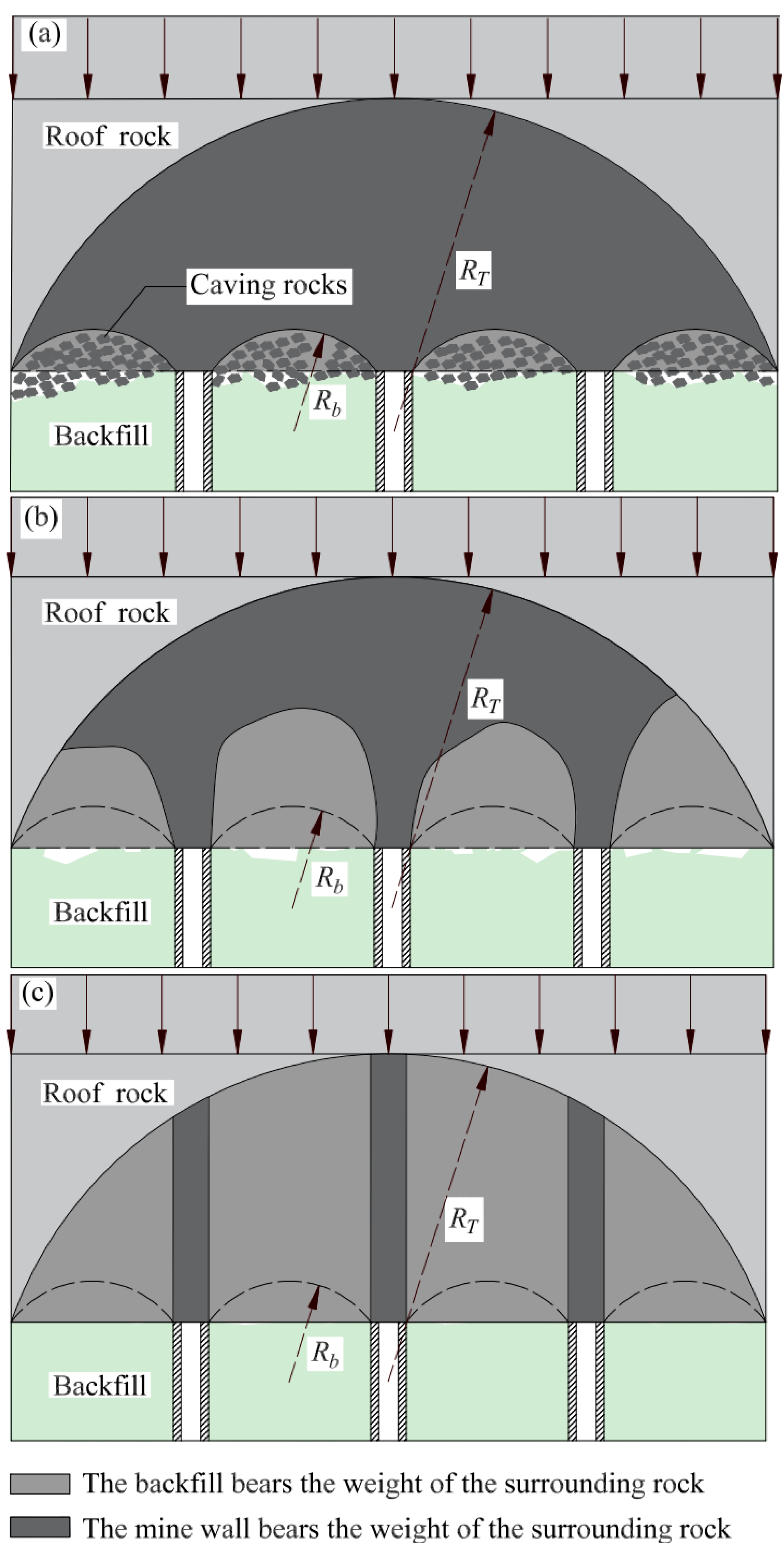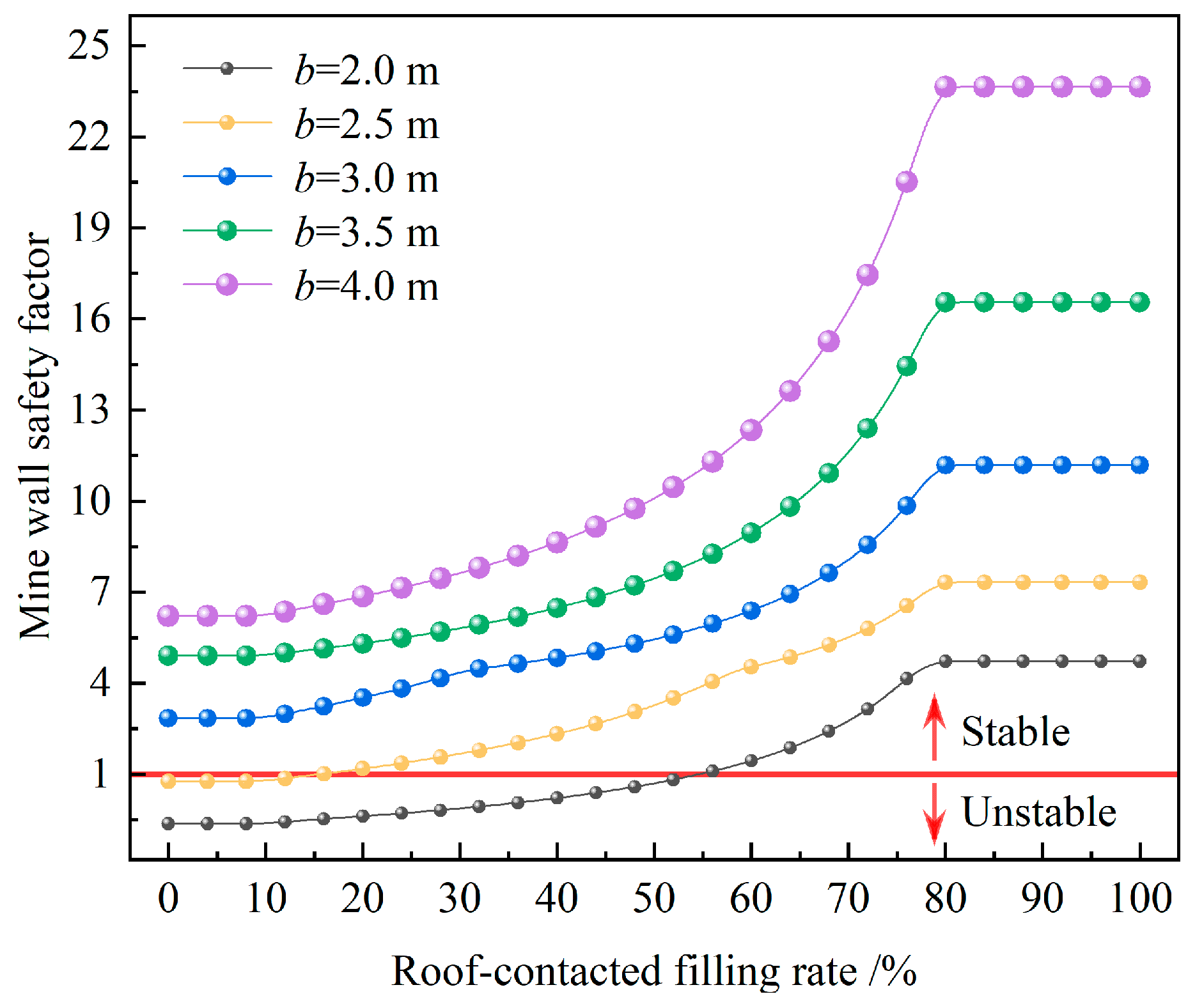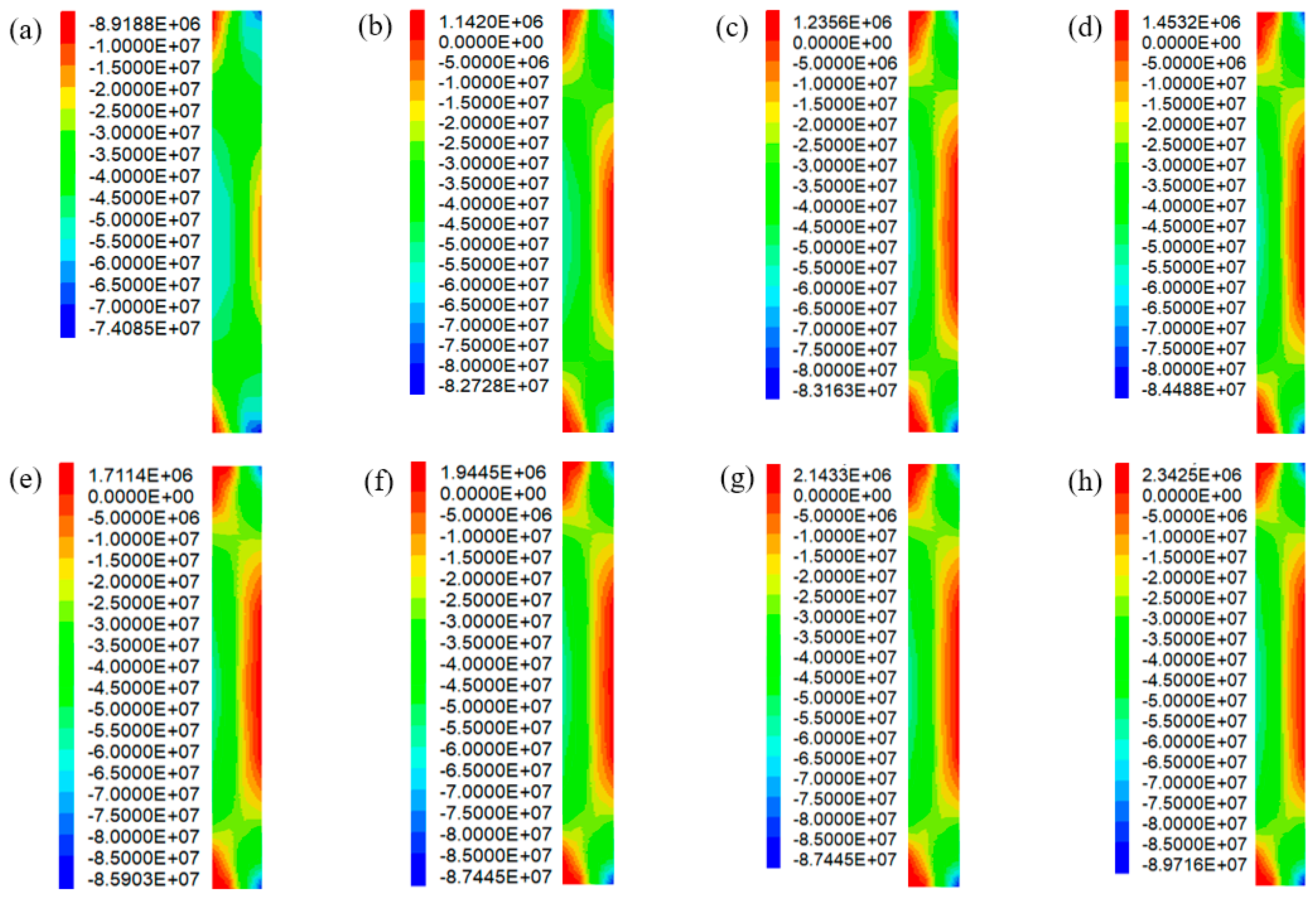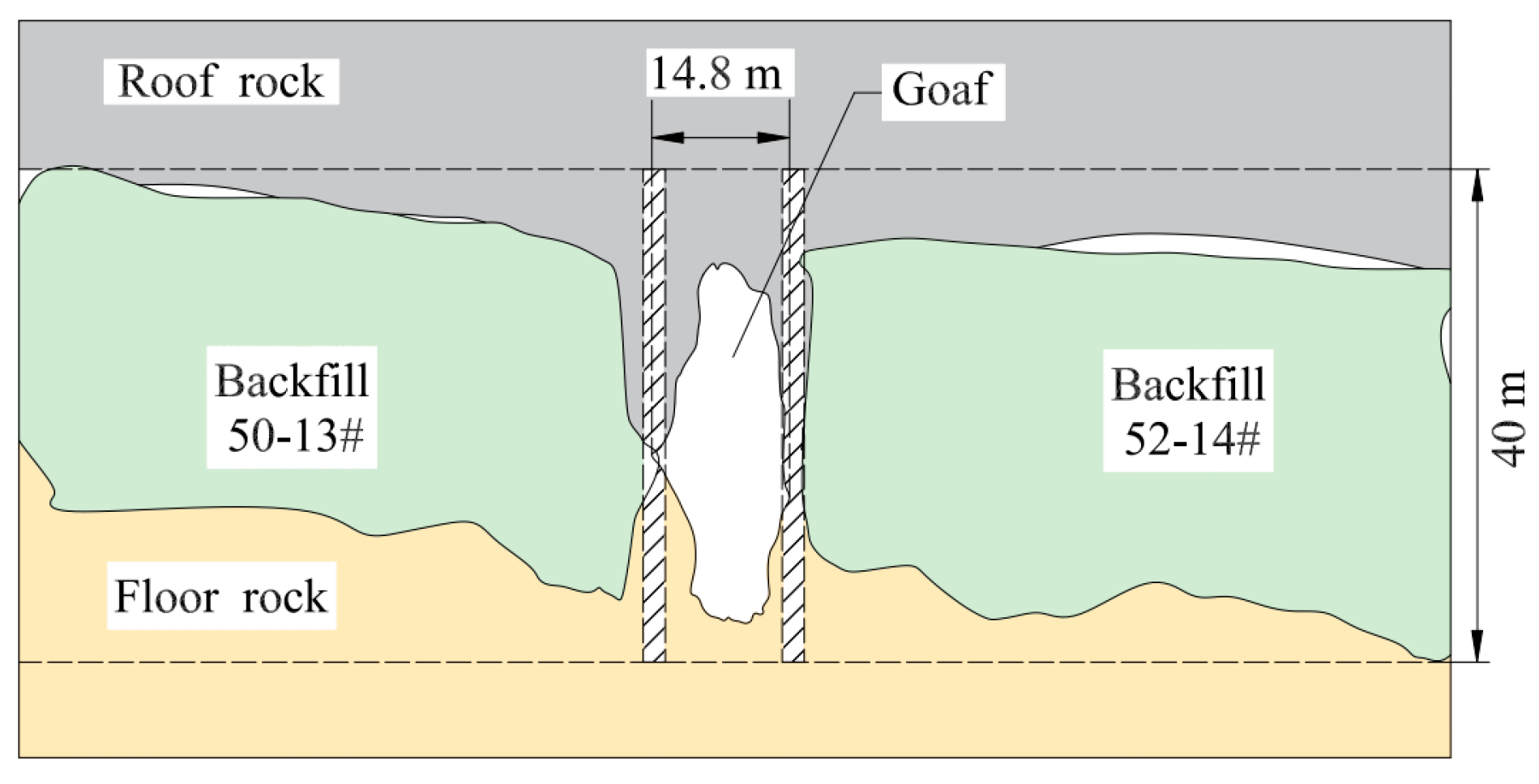Stability Analysis of a Mine Wall Based on Different Roof-Contact Filling Rates
Abstract
1. Introduction
2. Project Overview
3. Mining Wall Mechanics Model
- The mine wall is a uniform and continuous isotropic body.
- The deformation size of the mine wall is completely smaller than the size of the mine wall itself.
- The width of the wall is equal along its length.
- Only the roof-contacted filling rate is considered to influence the overburden load, and the influence of the shape change of the backfill is ignored.
3.1. Force Analysis of Mine Wall
3.2. Solving the Mine Wall Model Using the Energy Method
4. Influence of the Roof-Contacted Filling Rate on the Initial Load of the Mine Wall
4.1. Initial Load on the Mine Wall under State I
4.2. Initial Load on the Mine Wall in State II
4.3. Initial Load on the Mine Wall under State III
5. Stability Analysis of the Mine Wall and Stope Design
5.1. Calculation of Safety Factor
5.2. Analysis of Factors Influencing the Stability of the Mine Wall
5.3. Backfill Components
5.4. Mining Design Plan Based on Backfilling Method
6. Results and Discussion
6.1. Theoretical Calculation
6.2. Numerical Simulation
6.3. Field Test
7. Conclusions
- When the stopes parameters, rock, and backfill mechanical parameters are specific, the safety coefficient of the wall was calculated to vary with the roof-contacted filling rate under different wall width conditions; i.e., the safety coefficient of the wall and the roof-contacted filling rate under the same wall width showed a “trapezoidal” variation law. Considering the cost of stope backfilling and the variation pattern of the stope wall safety factor, when the roof-contacted filling rate is maintained within the range of 30% to 78.94%, the safety factor increases at a higher rate, resulting in better stope wall stability and higher overall benefits.
- The numerical simulation of isolated pillar mining and the width of the mine wall was set to 3 m, which revealed that the lateral force on the wall increased with rising roof-contacted filling rates. This confirmed that the self-weight of the backfill-bearing rock grows with increased filling rates. Meanwhile, simulations with different roof-contacted filling rates showed stresses lower than measured values, for the 3 m wide wall, maximum tensile stress at 2.34 MPa, and maximum compressive stress at 89.7 MPa. This indicates the wall’s stability, aligning with theoretical calculations.
- A mining field test was conducted on the G6 isolated mine pillar of Line 50. The final detection results showed that the mine wall with a width of 3 m was not damaged, the maximum displacement monitoring was 32 mm, and the deformation was within the controllable range. The field test is consistent with the theoretical calculation and numerical simulation. Consequently, the mine wall is stable.
Author Contributions
Funding
Acknowledgments
Conflicts of Interest
References
- Wang, Y.M.; Wu, A.X.; Chen, X.S.; Yang, B.H.; Su, Y.D. New mining technique with big panels and stopes in deep mine. Trans. Nonferr. Metal. Soc. 2008, 18, 183–189. [Google Scholar] [CrossRef]
- Yu, W.; Zhai, S.; Gao, Q. Stability evaluation indexes of deep stope pillar and roadway surrounding rock. Disaster. Adv. 2012, 5, 120–126. [Google Scholar]
- Chen, S.H.; Zhang, Z.H. Determination of coal pillar width and support parameters in deep coal mines—A case study. J. Test. Eval. 2018, 47, 3160–3173. [Google Scholar] [CrossRef]
- Tuncay, D.; Tulu, I.B.; Klemetti, T. Re-analysis of abutment angle method for moderate and deep cover retreat room and pillar mines and investigation of loading mechanics using finite volume modeling. Rock Mech. Rock Eng. 2021, 54, 3447–3468. [Google Scholar] [CrossRef]
- Kongar-Syuryun, C.B.; Kovalski, E.R. Hardening backfill at potash mines: Promising materials regulating stress-strain behavior of rock mass. Geologiya I Geofizika Yuga Rossii. 2023, 13, 177–187. [Google Scholar]
- Li, Y.L.; Lu, B.; Yang, R.S.; Lin, H.; Xu, B.; Wang, S.S.; Liu, C.H. Coal mining technology and typical engineering cases of coal mining by continuous mining with coal-filled colluvial filling. J. Coal. 2022, 47, 1055–1071. [Google Scholar]
- Kovalski, E.R.; Kongar-Syuryun, C.B.; Petrov, D.N. Challenges and prospects for several-stage stoping in potash minining. Sustain. Dev. Mt. Territ. 2023, 15, 349–364. [Google Scholar] [CrossRef]
- Li, C.; Zhou, J.; Armaghani, D.J.; Li, X. Stability analysis of underground mine hard rock pillars via combination of finite difference methods, neural networks, and Monte Carlo simulation techniques. Undergr. Space 2021, 6, 379–395. [Google Scholar] [CrossRef]
- Ding, H.X.; Li, G.H.; Dong, X.; Lin, Y. Prediction of pillar stability for underground mines using the stochastic gradient boosting technique. IEEE Access 2018, 6, 69253–69264. [Google Scholar] [CrossRef]
- Jiang, S.Y.; Fan, G.W.; Li, Q.Z.; Zhang, S.Z.; Chen, L. Effect of mining parameters on surface deformation and coal pillar stability under customized shortwall mining of deep extra-thick coal seams. Energy Rep. 2021, 7, 2138–2154. [Google Scholar] [CrossRef]
- Basarir, H.; Sun, Y.; Li, G. Gateway stability analysis by global-local modeling approach. Int. J. Rock Mech. Min. Sci. 2019, 113, 31–40. [Google Scholar] [CrossRef]
- Carter, T.G. Guidelines for Use of the Scaled Span Method for Surface Crown Pillar Stability Assessment. Available online: https://static.rocscience.cloud/assets/verification-and-theory/CPillar/Trevor_Carter_2014.pdf (accessed on 26 June 2024).
- Qin, X.S.; Cao, H.; Wang, Z.X.; Zheng, Z.J. Analysis on safe thickness of the horizontal separation pillar in the upward horizontal slicing and filling method. IOP Conf. Ser. Earth Environ. Sci. 2021, 861, 052051. [Google Scholar] [CrossRef]
- Idris, M.A.; Saiang, D.; Nordlund, E. Stochastic assessment of pillar stability at Laisvall mine using artificial neural network. Tunn. Undergr. Sp. Technol. 2015, 49, 307–319. [Google Scholar] [CrossRef]
- Xia, K.Z.; Chen, C.X.; Liu, X.T.; Liu, X.M.; Yuan, J.H.; Dang, S. Assessing the stability of high-level pillars in deeply-buried metal mines stabilized using cemented backfill. Int. J. Rock Mech. Min. Sci. 2023, 170, 105489. [Google Scholar] [CrossRef]
- Fakhimi, A.; Hosseini, O.; Theodore, R. Physical and numerical study of strain burst of mine pillars. Comput. Geotech. 2016, 74, 36–44. [Google Scholar] [CrossRef]
- Li, Q.H.; Li, J.K.; Wang, Z.Q.; Li, K.X.; Zhang, C.Z. Study on coal pillar size design based on non-integral contact structure of coal and rock under static and dynamic loads. Front. Mater. 2021, 8, 721713. [Google Scholar] [CrossRef]
- Kortnik, J.; Nwaubani, S.; Kos, A. High safety pillars stability control using EL beam displacement sensors in Lipica II quarry. Acta Geotech. Slov. 2014, 11, 41–48. [Google Scholar]
- Waclawik, P.; Ptacek, J.; Konicek, P.; Kukutsch, R.; Nemcik, J. Stress-state monitoring of coal pillars during room and pillar extraction. J. Sustain. Min. 2016, 15, 49–56. [Google Scholar] [CrossRef]
- Walton, G.; Diederichs, M.; Punkkinen, A.; Whitmore, J. Back analysis of a pillar monitoring experiment at 2.4 km depth in the Sudbury Basin, Canada. Int. J. Rock Mech. Min. Sci. 2016, 85, 33–51. [Google Scholar] [CrossRef]
- Das, A.J.; Mandal, P.K.; Bhattacharjee, R.; Tiwari, S.; Kushwaha, A.; Roy, L.B. Evaluation of stability of underground workings for exploitation of an inclined coal seam by the ubiquitous joint model. Int. J. Rock Mech. Min. Sci. 2017, 93, 101–114. [Google Scholar] [CrossRef]
- Hauquin, T.; Gunzburger, Y.; Deck, O. Predicting pillar burst by an explicit modelling of kinetic energy. Int. J. Rock Mech. Min. Sci. 2018, 107, 159–171. [Google Scholar] [CrossRef]
- Zhang, S.R.; Qiu, S.L.; Jiang, Q.; Jia, L.X.; Li, S.J.; Xie, Z.K. Effect of fully-grouted bolts on the failure behaviors of mine pillars: Insights from block-based FDEM modeling. Constr. Build. Mater. 2024, 419, 135468. [Google Scholar] [CrossRef]
- Sinha, S.; Walton, G. Investigation of pillar damage mechanisms and rock-support interaction using Bonded Block Models. Int. J. Rock Mech. Min. Sci. 2021, 138, 104652. [Google Scholar] [CrossRef]
- Ahmad, M.; Al-Shayea, N.A.; Tang, X.-W.; Jamal, A.; Al-Ahmadi, H.M.; Ahmad, F. Predicting the pillar stability of underground mines with random trees and C4.5 decision trees. Appl. Sci. 2020, 10, 6486. [Google Scholar] [CrossRef]
- Mohanto, S.; Deb, D. Prediction of Plastic Damage Index for Assessing Rib Pillar Stability in Underground Metal Mine Using Multi-variate Regression and Artificial Neural Network Techniques. Geotech. Geol. Eng. 2020, 38, 767–790. [Google Scholar] [CrossRef]
- Du, X.; Feng, G.; Zhang, M.; Wang, Z.; Liu, W. Influence of backfilling rate on the stability of the “backfilling body-immediate roof” cooperative bearing structure. Int. J. Min. Sci. Techno 2022, 32, 1197–1206. [Google Scholar] [CrossRef]
- Das, A.J.; Mandal, P.K.; Paul, P.S.; Sinha, R.K.; Tewari, S. Assessment of the strength of inclined coal pillars through numerical modelling based on the ubiquitous joint model. Rock Mech. Rock Eng. 2019, 52, 3691–3717. [Google Scholar] [CrossRef]
- Huang, Z.G.; Dai, X.G.; Dong, L.J. Buckling failures of reserved thin pillars under the combined action of in-plane and lateral hydrostatic compressive forces. Comput. Geotech. 2017, 87, 128–138. [Google Scholar] [CrossRef]
- Wang, X.R.; Guan, K.; Yang, T.H.; Liu, X.G. Instability mechanism of pillar burst in asymmetric mining based on cusp catastrophe model. Rock. Mech. Rock. Eng. 2021, 54, 1463–1479. [Google Scholar] [CrossRef]
- Wang, T.T.; Yang, C.H.; Yan, X.Z.; Daemen, J.J.K. Allowable pillar width for bedded rock salt caverns gas storage. J. Petrol. Sci. Eng. 2015, 127, 433–444. [Google Scholar] [CrossRef]
- Reed, G.; McTyer, K.; Frith, R. An assessment of coal pillar system stability criteria based on a mechanistic evaluation of the interaction between coal pillars and the overburden. Int. J. Min. Sci. Technol. 2017, 27, 9–15. [Google Scholar] [CrossRef]
- Behera, B.; Yadav, A.; Singh, G.S.P.; Sharma, S.K. Numerical Modeling Study of the Geo-mechanical Response of Strata in Longwall Operations with Particular Reference to Indian Geo-mining Conditions. Rock Mech. Rock Eng. 2020, 53, 1827–1856. [Google Scholar] [CrossRef]
- Das, A.J.; Mandal, P.K.; Ghosh, C.N.; Sinha, A. Extraction of locked-up coal by strengthening of rib pillars with FRP—A comparative study through numerical modelling. Int. J. Min. Sci. Technol. 2017, 27, 261–267. [Google Scholar] [CrossRef]
- Jawed, M. Design of rhombus coal pillars and support for Roadway Stability and mechanizing loading of face coal using SDLs in a steeply inclined thin coal seam. Arab. J. Geosci. 2018, 11, 415–426. [Google Scholar] [CrossRef]
- Ma, Z.; Chen, C.; Liang, X.; Chen, A.; Song, W. Field and numerical investigation on the stability of coal pillars of gob-side entry driving with top coal. Arab. J. Geosci. 2020, 13, 1193. [Google Scholar] [CrossRef]
- Han, P.H.; Zhang, C.; Wang, W. Failure analysis of coal pillars and gateroads in longwall faces under the mining-water invasion coupling effect. Eng. Fail. Anal. 2022, 131, 105912. [Google Scholar] [CrossRef]
- Ibishi, G.; Genis, M.; Yavuz, M. Post-pillars design for safe exploitation at Trepca hard rock mine (Kosovo) based on numerical modeling. Geomech. Eng. 2022, 28, 463–475. [Google Scholar]
- Prakash, A.; Kumar, B.A.; Paul, A. MultiState assessment of post-mining effect on railway structures: A case study of Jharia Coalfield. J. Earth Syst. Sci. 2023, 132, 0154. [Google Scholar] [CrossRef]
- Kumar, S.; Sinha, R.K.; Jawed, M.; Murmu, S. Assessment of coal pillar strength under the influence of sand stowing in deep coal mines. Geotech. Geol. Eng. 2024, 42, 2815–2831. [Google Scholar] [CrossRef]
- Wang, J.; Huang, K.F.; Fu, J.X.; Song, W.D. Mechanical Behavior and Crack Evolution of Goaf Surrounding Rock with Different Roof-Contacted Filling Rates. Materials 2023, 16, 4435. [Google Scholar] [CrossRef]
- Guo, J.; Feng, Y.F. Cusp catastrophe theory analysis and width optimization on instability of pillar in deep mining. J. Saf. Sci. Technol. 2017, 13, 111–116. [Google Scholar]
- Zhao, K.; Yan, H.B.; Feng, X.; Wang, X.J.; Zhang, J.P.; Zhao, K. Stability analysis of pillar based on energy law. Chin. J. Theor. Appl. Mech. 2016, 48, 976–983. [Google Scholar]
- Guo, J.; Zhao, Y.; Zang, W.X.; Dai, X.G.; Xie, X.B. Stress analysis of mine wall in panel barrier pillar-stope under multi-directional loads. J. Cent. South Univ. (Sci. Technol.) 2018, 49, 3020–3028. [Google Scholar]
- Wu, A.C.; Shen, H.M.; Jiang, L.C.; Jiao, H.J.; Wang, Y.M. Arch effect of narrow and long filler and its effect on target strength. Chin. J. Nonferrous Met. 2016, 26, 648–654. [Google Scholar]
- Jiang, L.C.; Chen, P.; Wu, A.X. Self-stabilization effect of roof arch in mining area based on different filling jointing rates. Chin. J. Nonferrous Met. 2019, 29, 187–193. [Google Scholar]
- Ghasemi, E.; Ataei, M.; Shahriar, K. Prediction of global stability in room and pillar coal mines. Nat. Hazards 2014, 72, 405–422. [Google Scholar] [CrossRef]
- Zhang, J.X.; Huang, P.; Zhang, Q.; Meng, L.; Chen, Z.W. Stability and control of room mining coal pillars—Taking room mining coal pillars of solid backfill recovery as an example. J. Cent. South Univ. 2017, 24, 1121–1132. [Google Scholar] [CrossRef]
- Jessu, K.V.; Spearing, A.J.S. Direct strain evaluation method for laboratory-based pillar performance. J. Rock Mech. Geotech. 2019, 11, 860–866. [Google Scholar] [CrossRef]
- He, Y.; Huang, Q.; Wei, Y.; Du, J. Research on roof load transfer by passing coal pillar of working face in shallow buried closely multiple-seam. Minerals 2023, 13, 118. [Google Scholar] [CrossRef]
- Qiu, H.; Huang, M.; Weng, Y. Stability evaluation and structural parameters optimization of stope based on area bearing theory. Minerals 2022, 12, 808. [Google Scholar] [CrossRef]
- Kongar-Syuryun, C.; Klyuev, R.; Golik, V.; Oganesyan, A.; Solovykh, D.; Khayrutdinov, M.; Adigamov, D. Principles of Sustainable Development of Georesources as a Way to Reduce Urban Vulnerability. Urban Sci. 2024, 8, 44. [Google Scholar] [CrossRef]








| Chemical Composition | SiO2 | Al2O3 | CaO | MgO | TFe | S | Cu |
|---|---|---|---|---|---|---|---|
| Mass Fraction/% | 30.16 | 3.37 | 14.92 | 5.87 | 14.06 | 6.06 | 0.14 |
| Test Number | FA/S Ratio | Concentration/% | Strength/MPa | |||
|---|---|---|---|---|---|---|
| 3 d | 7 d | 28 d | 60 d | |||
| 1-1 | 1:4 | 66 | 0.45 | 0.82 | 1.64 | 2.04 |
| 1-2 | 68 | 0.57 | 1.01 | 1.71 | 2.45 | |
| 1-3 | 70 | 0.74 | 1.23 | 1.82 | 3.17 | |
| 1-4 | 72 | 0.77 | 1.49 | 1.98 | 3.66 | |
| 1-5 | 74 | 1.04 | 1.73 | 2.27 | 4.93 | |
| 2-1 | 1:6 | 66 | 0.30 | 0.74 | 0.90 | 1.45 |
| 2-2 | 68 | 0.32 | 0.77 | 1.09 | 1.46 | |
| 2-3 | 70 | 0.35 | 0.80 | 1.17 | 1.47 | |
| 2-4 | 72 | 0.37 | 0.83 | 1.28 | 1.67 | |
| 2-5 | 74 | 0.39 | 0.86 | 1.38 | 1.98 | |
| 3-1 | 1:8 | 66 | 0.22 | 0.36 | 0.63 | 0.76 |
| 3-2 | 68 | 0.24 | 0.38 | 0.66 | 0.79 | |
| 3-3 | 70 | 0.25 | 0.42 | 0.72 | 0.96 | |
| 3-4 | 72 | 0.28 | 0.47 | 0.83 | 0.98 | |
| 3-5 | 74 | 0.35 | 0.55 | 1.06 | 1.23 | |
| 4-1 | 1:12 | 66 | 0.21 | 0.27 | 0.38 | 0.52 |
| 4-2 | 68 | 0.20 | 0.28 | 0.40 | 0.53 | |
| 4-3 | 70 | 0.2 | 0.30 | 0.43 | 0.57 | |
| 4-4 | 72 | 0.22 | 0.32 | 0.47 | 0.63 | |
| 4-5 | 74 | 0.23 | 0.34 | 0.51 | 0.67 | |
| Name | E/GPa | c/MPa | /° | /MPa | /KN·m−3 | |
|---|---|---|---|---|---|---|
| Roof rock | 6.835 | 0.329 | 12.00 | 50.28 | 1.70 | 27.5 |
| Mine wall | 6.529 | 0.312 | 11.69 | 45.07 | 3.04 | 32.2 |
| Floor rock | 6.487 | 0.257 | 11.14 | 40.02 | 2.24 | 27.2 |
| Backfill | 0.570 | 0.200 | 1.55 | 35.70 | 0.10 | 20.0 |
Disclaimer/Publisher’s Note: The statements, opinions and data contained in all publications are solely those of the individual author(s) and contributor(s) and not of MDPI and/or the editor(s). MDPI and/or the editor(s) disclaim responsibility for any injury to people or property resulting from any ideas, methods, instructions or products referred to in the content. |
© 2024 by the authors. Licensee MDPI, Basel, Switzerland. This article is an open access article distributed under the terms and conditions of the Creative Commons Attribution (CC BY) license (https://creativecommons.org/licenses/by/4.0/).
Share and Cite
Guo, J.; Yang, W.; Zhao, Y.; Zhang, W. Stability Analysis of a Mine Wall Based on Different Roof-Contact Filling Rates. Minerals 2024, 14, 673. https://doi.org/10.3390/min14070673
Guo J, Yang W, Zhao Y, Zhang W. Stability Analysis of a Mine Wall Based on Different Roof-Contact Filling Rates. Minerals. 2024; 14(7):673. https://doi.org/10.3390/min14070673
Chicago/Turabian StyleGuo, Jiang, Wenjun Yang, Yan Zhao, and Wanzhong Zhang. 2024. "Stability Analysis of a Mine Wall Based on Different Roof-Contact Filling Rates" Minerals 14, no. 7: 673. https://doi.org/10.3390/min14070673
APA StyleGuo, J., Yang, W., Zhao, Y., & Zhang, W. (2024). Stability Analysis of a Mine Wall Based on Different Roof-Contact Filling Rates. Minerals, 14(7), 673. https://doi.org/10.3390/min14070673






